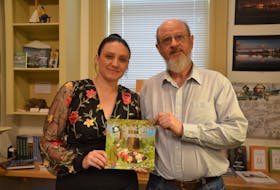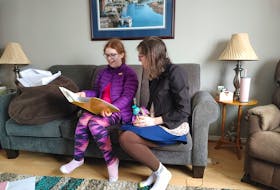Briana Fletcher thought she was just a late developer and that menstruation would happen soon. But by age 16, a trip to the doctor affirmed it was much more severe.
"I screamed and cried at the news after having an ultrasound and M.R.I. (magnetic resonance imaging) to confirm. It was hard to hear, and I was furious," said Fletcher, now 26 and living on the South Shore of Nova Scotia.
Fletcher has Mayer-Rokitansky-Küster-Hauser (MRKH) syndrome, a rare disorder that occurs in females and is characterized by the Müllerian duct's failure to develop. For Fletcher, not going through menstruation became the first noticeable sign. She was born without a womb where a baby could grow.
"The doctor told me the only chance I could have at a family would be through adoption, which I was OK with, but I wanted biological children. In vitro fertilization (IVF) and surrogacy were not nearly advanced as they are now, and uterus transplants have just started opening the door for others."
Fletcher and her boyfriend, Bryton Cook, investigated surrogacy – having someone carry a child for them – but the costs were anywhere in the ballpark of $20,000 to $100,000. Fletcher does have ovaries and could have her own eggs extracted for use by a surrogate, so the child would be biologically hers.
But public adoption became the most viable option for Fletcher and Cook.
"We are looking to adopt an older child (age three or older) through the Department of Children and Family Services (DCFS) process. There is a huge need for families to adopt older children and sibling groups," she said, while acknowledging that infants under five generally find homes quicker.

Need for families
Lynette MacLeod, a spokesperson for the Nova Scotia Department of Community Services, said the average length of time a child under five is in ‘Permanent Care and Custody’ of the province before an adoption is one-and-a-half years.
"Nova Scotia also has an adoption probation period. Before the adoption is granted, the child is placed with the adoptive family to ensure the placement is a good fit. The average probation time is approximately one year, and this probation is included in all our figures,” she said.
Over age five, the average length of time a child is in custody of the province before adoption is approximately two-and-a-half years.
As of Aug. 30, there were 369 children and youth in custody of the province while being fostered and awaiting adoption.
“Every effort is made to ensure siblings are adopted together in cases where there are sibling groups,” said MacLeod.
From 2019 to 2020, 81 children were adopted (for infants to age four there were 44, ages five to 11 there were 30, and ages 12 to 15 there were seven). Some children are currently living with adoptive parents within those numbers, according to MacLeod, pending the completion of the adoption probation in N.S.
"Our priority is to place children in appropriate care. We always seek families with the qualifications and strengths to meet the specific needs, including any special considerations. Special considerations include physical or learning disabilities, medical or behavioural problems, prior abuse, keeping siblings together, and finding a home compatible with the child's culture," said MacLeod.
Meanwhile, in Newfoundland and Labrador, there are currently 220 children living in foster homes with adoption identified as their permanency plan, says Brian Warr, minister of the Department of Children Seniors and Social Development (CSSD). In 2019 to 2020, a total of 35 children were adopted.
"CSSD prepares a plan for every child in care. Their plan is family reunification for many children in care; however, children in continuous custody may have adoption as their plan. Each case is assessed on an individual basis following the best interests of the child. It is paramount that children eligible for adoption are matched with loving and supportive families promptly," said Warr.
In 2003, the wait time for applicants in Newfoundland and Labrador was 10 to 12 years, but this has decreased in recent years.
"For infants under 24 months with minimal or no known developmental issues, the wait time can be approximately seven years,” Warr said. “However, for those applicants interested in accepting older children, children with complex needs, or in larger sibling groups, the wait times can be significantly lower."
Children’s best interests

Matt Bourque, the provincial adoption coordinator with the Department of Social Development and Housing in P.E.I., said several criteria from applicants are assessed based on the children's best interests.
"The first step is to complete an application which will then be assessed by Adoption Services, who will contact you for further assessment and consideration. This process may include interviews, home visits, and employment verification, among other measures to ensure that applicants can provide a stable, loving, and caring home for children," he said.
"There is no cost for public adoption assessment on P.E.I. The only cost incurred by prospective adoptive parents are the legal fees at the time of adoption finalization. These costs vary depending on what the lawyer charges. As for private, we could not say. However, it would be significantly more than departmental adoptions.”
The number of children currently in P.E.I. foster care is 108, and less than 10 were adopted last year.
"This number, however, does not reflect the number of children currently legally available for adoption on the Island, but we would not disclose the actual number due to confidentiality and privacy concerns," said Bourque.
"The goal for children in care is to return them safely to their parent(s). If that is not possible and a child is in our permanent care, then having that child placed with an adoptive family is our number one goal."
When asked about adoption waiting times on the Island, there was no comment.
"We have many hoops to jump through, but that is part of the course,” said Fletcher. “The training and paperwork all help secure safe and loving environments for these children. It is time-consuming but worth the result if approved."
International adoptions

For individuals considering intercountry adoption, the route can be quicker - but it’s also costly and complicated.
"In some cases, the wait for a child placement may not be as long internationally in comparison to departmental adoptions, there is a high financial cost," said Bourque while acknowledging there have been families that have registered for international adoption on P.E.I.
Bourque said those on P.E.I. wishing to adopt internationally must first find a Canadian agency licensed to facilitate adoptions from the country they want to adopt.
"Once the agency is selected, Adoption Services would establish a working relationship with the agency. Individuals would then contract an authorized social worker who would conduct the home study and send it to the agency," he explained.
After review, the agency would inform Adoption Services of a child proposal.
In Newfoundland, Warr says, "In addition to meeting the same provincial screening requirements as they would for a domestic adoption application, intercountry adoption applicants will have additional considerations depending on the country selected, such as processes and costs involved."
Before a Nova Scotia family can adopt, either domestically or internationally, a home study must be completed to ensure the family can meet the needs of the child. For international adoption, the length of time for the placement of a child varies, but all costs must be covered by the applicant.
When asked why adoption should be considered, all were in unison.
"Family is the basic unit of society responsible for children's care and upbringing," said Warr.
"Adoption is a legal process that connects a child physically and emotionally to a loving family permanently and allows a child to develop meaningful relationships that are intended to last a lifetime. It will enable adoptive parents to care for a child or youth, which they may never otherwise have had.
"Plus, adoption allows birth parents to place their child in a loving home after they have determined they are unable to care for their child."
For Fletcher becoming a parent means providing that safe space.
"Giving the child food security, a warm bed to sleep in, someone to help with homework and kiss boo-boos and chase the monsters away. To deal with the temperamental tweens and teens, to be a sounding board for their frustrations and concerns over their lifetime," she said.









